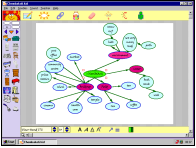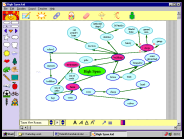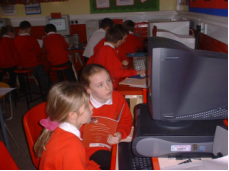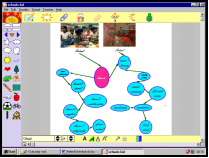
 |
Teaching Thinking and ICT |
|
Thinking
Skills, ICT and Geography
|
 |
 |
We had already established pairs who worked well together on the computers,
usually a poorer reader with a better one. Using the frame on the
screen as a guide they began creating their own concept maps. Starting
with High Spen seemed logical, as they didn't have to refer to the
map very often to check ideas. Discussion between Year3 and Year 4
pupils began on whether we should include things that used to be in
the village. The Year 4 children had looked at the history of the
village in depth and they knew there used to be a cinema and more
shops. This led to a discussion on our knowledge of the history of
Chembakolli. Could we justify taking our previous knowledge of High
Spen into account? We decided that we could only use the knowledge
we had gained from looking at the maps we had in front of us. This
level of discussion came from the links the children had been making
and their ability, through other thinking skills strategies, to question
and reason at quite a high level.
One of the benefits of working with concept maps is that they require children to make links between ideas and to find reasons and justifications for these links. When we first began using concept maps the children would join everything to the central idea and there would be no thought in their attempts to link ideas. This activity took place half way through the year and the maps show that children have begun to make links between ideas and concepts and discussion showed that they could justify and explain their links clearly. (If children are required to justify and explain their maps a 'pole bridging' improvement is made which means that the children are re-enforcing their own learning and building upon it.)
The children also used photographs to enhance their maps and spent a long time deciding which pictures were suitable for which aspect of the maps. Some even insisted on using the digital camera to take pictures of our school to use as a comparison. This pair decided just to compare school life and their maps were complex but informative.
 |
 |
The concept maps that the children produced were informative and focused their thinking on the similarities and differences between the two villages. We use concept mapping like this at the beginning and end of most topics and the children are keen to see their own knowledge expand in a logical way. The benefits of concept mapping can be seen in most topic areas; children extend logical ideas and begin to think carefully about groupings and links. This activity in particular raised the skills and knowledge of the children in Geography. They were motivated to learn about life in Chembakolli from looking at the map and from seeing their own words on the large screen ready to be turned into a useful tool. (They are keen to see themselves and facilitators of their own learning and love the idea that what they produce will help not only themselves, but others, to learn.)
By adopting this thinking skills strategy the children not only became much more focused on the similarities and differences between themselves and children in Chembakolli but they were motivated to find out more. As a teacher I couldn't ask for more than for the children to be motivated, keen learners and the feedback from the children during our weekly 'what I have achieved' sessions proved that they too are proud and pleased with what they have learned and achieved.
Further information
Leat, D. (1998) Thinking Through Geography Cambridge: Chris
Kington Publishing ISBN 1-899857-42-7.
Smith, A. (1998) Accelerated Learning in Practice Stafford:
Network Educational Press (http://www.alite.co.uk/ )
Smith A., Call, C and Batton J. (1999) The ALPS approach: Accelerated
Learning in Primary Schools (revised edition) Stafford: Network
Educational Press Ltd ISBN: 1-855390-56-6.
|
The kidspiration sample files used in this activity are linked here; Links
for PC;HBChembokolli Note that you may need to install the demo version of Kidspiration before these links will work... |
|
| Demo version
of Kidspiration for PC
- and for Mac |
|
|
Demo version of Inspiration for PC - and for Mac Kidspiration (Inspiration Software, Inc. www.inspiration.com ) |